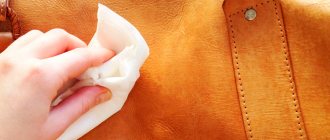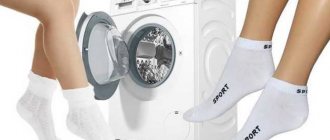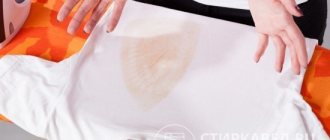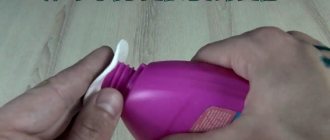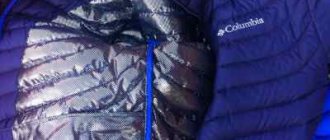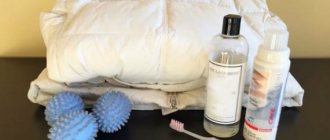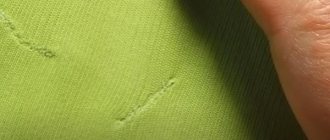Let's look at the features of ironing a jacket and the procedure depending on the type of fabric: bologna, suede, polyester. The main thing you need to do when planning to iron a product at home is to carefully study the labels indicating the acceptable ironing modes, as well as the composition of the materials of the top, lining and filler.
After this, you need to prepare an iron with a temperature regulator and a steamer, an ironing cloth and a water container (if necessary), an ironing board or a flat surface, and a terry towel.
How to iron polyester fabric
To choose the right ironing mode, you need to read the fabric composition of the product. If the manufacturer has added other fibers to the fabric, then their characteristics must be taken into account. A polyester jacket or raincoat can be ironed in the following ways:
- Using a steamer (steam generator) or an iron with a vertical steam supply function (steam boost). At home, the raincoat can be hung on hangers or ironed horizontally. The fabric is not ironed; a lot of steam is simply applied to it. After this, you need to hang the item on hangers to smooth it out. This method is used to iron a leather coat.
- You can steam the raincoat using wet natural fabric (cotton). A polyester item needs to be flattened and a lightly wrung out piece of cotton material placed on it. Iron with a hot iron and make sure the fabric is constantly damp.
- Some manufacturers recommend ironing a polyester raincoat or jacket. But the temperature regime should be minimal. Sometimes outerwear manufacturers sew on a test piece of material with the same composition. With its help, you can select the ironing temperature for the product.
- At home, the raincoat is ironed when it is not yet completely dry. A damp item is easier to iron and there is less chance of damaging the material.
To achieve excellent results, maintain some consistency when ironing. Start the procedure with the collar: first the wrong side, then the front side. You need to iron from the edges to the middle.
The back part of the cloak is folded in half and carefully smoothed. After this, the bend line is steamed. The shoulder part is ironed separately, pulling it onto a special side of the board or well leveled. The front of the coat or jacket should be ironed last. Here you need to carefully steam the areas with loops and buttons (if any).
Complaints about not being able to iron a raincoat fabric are unfounded. Manufacturers make things in such a way that caring for them does not cause trouble. The labels always contain information that will help you properly wash, dry and iron a polyester item.
Using an iron
If, as a result of some circumstances, your clothes still turn out to be very wrinkled, you will have to use an iron. Proceed as follows:
- Carefully inspect the clothing. If the label is still on it, look at what temperature the manufacturer recommends ironing the product at.
- Wet the polyester in cold water, wring it out gently and wait until the fabric dries a little.
- Outerwear is often accompanied by a small piece of material from which a coat or raincoat is made. It can be used as a test sample, selecting the optimal ironing temperature.
- Set the iron control to silk and turn the garment inside out. Cloaks, coats and other outerwear begin to be ironed from the lining without pressing on the fabric. To avoid damaging the material, you can place damp gauze or a wet cotton towel under the iron.
- If after this treatment your coat still looks wrinkled, you will have to iron it on the outside as well. This should also only be done through damp gauze, so as not to spoil the item.
- Try gently increasing the temperature of the iron to straighten any particularly wrinkled areas. Before ironing folds, test how the polyester behaves somewhere inconspicuous - for example, on the back of the turn-down collar of your raincoat or coat.
- After ironing, do not immediately put the clothes in the closet - let them hang on hangers at room temperature for about two hours. During this time, the product will finally dry and take the desired shape.
Features of ironing outerwear made of synthetic fabrics
If the product label indicates that it can be exposed to an iron or steam generator, then we can assume that half of your problem has already been solved. You can iron such a jacket at home in the following ways:
- Bring the heated iron, switched to steam mode, as close as possible to the front surface of the product, but at the same time avoiding contact of the sole with the fabric. Using smooth sliding movements, pass a steam jet along the entire length of the jacket, laid out in a horizontal position. It will be good if your electric assistant is equipped with a vertical steam function. Then the jacket will be easy to iron while hanging.
- If the first method seems too complicated to you, a piece of cotton fabric will help simplify the task. It should be moistened and spread on the surface of the product. Ironing is carried out directly on the fabric with an iron heated to the temperature permitted by the manufacturer.
- Thick polyester can be ironed without additional protection, but before you start doing this, it’s worth doing a little experiment using a piece of fabric, usually included with spare buttons or other accessories for the product. If such an element was not included with your jacket, you can test a small area on the reverse side. If the fabric in this area melts or hardens under the influence of temperature, another method should be used to remove the bruises.
- Happy owners of a steam generator can iron their bolognese jackets and coats on padding polyester in a mode that provides a constant supply of steam. The ability to carry out the procedure in a vertical position greatly facilitates the task of bringing the product into a wearable form. By the way, this is exactly how pre-sale preparation of outerwear is done in stores. Hot steam, in addition to removing bruises, removes unpleasant odors and stains from fabric.
- Thin bologna jackets without filling can be ironed from the lining side. In this case, there will definitely be no traces of the iron left on the front surface of the product.
For any type of ironing, you must follow this sequence of procedures. First, the back and shelves are smoothed or steamed, then the shoulders and sleeves. Collars, hoods and cuffs are processed last. The surface on which jackets are ironed should be soft and not have any protruding parts. All irregularities will be imprinted on the outside of the product. A large sheet folded in several layers will do. After ironing is completed, the jacket should be hung on hangers for final drying.
Studying the label
First, let's study the instructions describing how to handle this or that item, taking into account the characteristics of the fabric and filler. If the company that produces down jackets is quite reputable, then it issues recommendations in the form of small, palm-sized books that are attached to clothing.
But basically all the information is printed on the label in encrypted form. Conscientious manufacturers will also put samples of fabric, accessories and filling in a plastic bag.
- The word "CLO" on the label indicates the degree of thermal insulation. CLO 1 - for warm, CLO2 - for medium, CLO 3 - for severe winters with severe frosts.
- Next, we look at what filling the down jacket has. In the strict sense of the word, not all “down jackets” contain down. If it is there, then its ratio in the composition of other fillers is different. Often this information is indicated through a fraction, where the first value is fluff and the second is feather. Down is down, feather is a feather. If the lining consists of batting, then the word “cotton” will be indicated, “wool” - wool batting, and if the down jacket is made of polyester, that is, padding polyester, then - “polyester”.
- If there is an icon with a crossed out steam on the label, then it is prohibited to steam such an item.
- If the down jacket cannot be ironed, then on the label there will be an icon in the form of an iron crossed out crosswise. This means that things will have to be brought to the desired state in some other way other than ironing. You can use steam from an iron, a steam brush or mop, or a vertical steamer device.
If the icon contains delicate washing at low temperatures, but does not say about steaming, then you can steam with an iron without touching the fabric, but only by turning on the steam.
Ironing jackets made of textile materials
The properties of the fabrics from which outerwear is made determine how to care for it.
It is important that the material is waterproof and not blown through. Synthetic bologna fabric meets these conditions
It has been known since the mid-20th century and is named after the Italian city of Bologna, where it was first made. The material is nylon or nylon treated with polymer acrylate and silicone impregnations.
To avoid damaging the fabric, items made from bologna should not be cleaned with organic solvents (containing acetone) or ironed with an iron heated above +100 °C.
Jackets made of nylon (100% polyester) are very popular: this material is breathable, things made from it are easy to wash and clean from stains. It is also not resistant to acetone and high temperatures.
Fabric care instructions are indicated on the label.
Clothing made from synthetic fabrics has useful qualities:
- can be washed at 30°C;
- does not shrink or deform when washed;
- does not fade and dries quickly;
- fabrics do not fade or deteriorate in the sun;
- practically does not wrinkle when worn;
- Resistant to stains.
Putting you under oppression
If there are single large bruises, it is easier not to hang outer clothing, but to lay it out on a flat surface in the correct position and put a light pressure on top of the problem areas, covered with a clean cloth. The process of leveling under pressure must be monitored and the condition of the skin checked every 2-3 hours so as not to crush or deform the soft surface.
Pressing with pressure is especially effective when you need to smooth out small wrinkled areas near fasteners, buttons, and decorative elements.
How to iron a jacket at home?
There are no particular difficulties in how to iron a down jacket, but you should still know some nuances. Ironing down products is not so difficult, the main thing is to follow all the rules and be careful.
First of all, read the label. Each high-quality item has instructions for use. It reflects the washing conditions of the item, as well as the ironing temperature.
Make sure that this particular material from which the down jacket is made can be ironed. If so, what ironing temperature can be used.
So, let's look at the existing methods of ironing down jackets.
There are several ways to smooth down down products.
The first, standard method is traditional ironing with an iron.
In this case, the down jacket can be ironed only at minimum power (at a temperature not exceeding 110 0 C). In this case, ironing is carried out from the front side, pressing each section of the fabric with an iron. It is better to carry out this ironing option through gauze or thin fabric to avoid the formation of shiny marks on the product.
The inside of a down jacket can be ironed without any fabric. If the iron has a steaming function, the process will be much faster and easier.
The second, accessible method is vertical steaming with an iron.
If your iron has a steam boost function, don't neglect it. Since in this case the down jacket can be ironed without pressing down the down.
At the same time, hang the product on a hanger in a certain convenient place
Then consistently and carefully expose the down jacket fabric to steam flows from the iron at a distance of at least 15 cm. Steam over the entire surface of the jacket
This method is good because it eliminates the possibility of excessive pressure and jamming of the fluff.
The third, popular method is ironing without an iron.
To do this, it is enough to prevent down products from overdrying after washing and carry out the drying itself according to all the rules.
And also, to get rid of small wrinkles on the fabric, just fill the bathtub with boiling water and hang the down jacket over it on a hanger. When exposed to warm steam, the product will straighten itself. Then let the down jacket dry completely in a dry, ventilated area.
These ironing methods are recommended by professionals who know the composition of materials and how to care for them. Each owner of a down item has the right to decide for himself which method to choose. Therefore, no matter which option you choose, we assure you that ironing a down jacket at home will not require much effort or time for you. And the down jacket will only have a new look!
The creators of jackets made with natural down opened the world to the pleasure of winter: in beautiful, practical and almost weightless down jackets you can spend the whole frosty day outside and not freeze!
If you don’t know how to iron a bologna jacket, you should adopt the secrets of specialists that will help you avoid mistakes when caring for products made from synthetic fabric. Is it possible to iron a down jacket and how to do it correctly
Known for its durability and excellent waterproof properties, outerwear is at the peak of its popularity today. Practical products have proven themselves to be worn well. But after washing, it may be necessary to straighten out wrinkles or creases. Recommendations on how to iron a polyester jacket without damaging the synthetic fabric are outlined on the product label, so do not ignore the manufacturer's care advice. Depending on the composition, density and quality of the fabric, different temperature conditions are offered for ironing.
Curtains and tulle curtains made of synthetics
In the last couple of years there has been a lot of interest in synthetic materials in the production of curtains.
This is not surprising, since such products are more airy and have an original structure. Naturally, problems may arise here when ironing the fabric, and we will try to tell you in detail how to quickly iron large-sized tulle so as to maintain the appearance of the curtains at a high level.
Important Tips:
- It is advisable to iron products immediately after washing, when the fabric is damp. Try not to use a spray bottle as fine droplets of water may cause streaks on the fabric once it dries.
- If you are working with viscose, you can use the steaming function, but it is better to iron from the inside out.
- Silk is ironed on either side, placing paper under the iron in advance.
The main rule: do not turn on the maximum temperature mode when working with synthetic products (no more than 120 °) so that the fabric does not change color.
Also, try to use an intermediate material between the curtain and the iron when ironing. This will prevent dark yellow marks from appearing on the curtains.
Multi-component “bomb”
A quick and effective home remedy for wrinkles in artificial leather. To prepare it you will need drinking water, table vinegar (9% alcohol solution) and fabric softener - all products in equal proportions.
Procedure:
hang clothes on hangers over the bathtub or sink; mix the ingredients; pour the product into a container with a spray bottle; Spray the mixture liberally onto the surface of the jacket (raincoat, etc.)
d.), paying special attention to the places of the deepest dents; leave the clothes to dry in the bathroom. Any of the described operations with leatherette should be carried out carefully
Then the jacket or raincoat will again acquire an excellent appearance and will delight its owner for a long time
Any of the described operations with leatherette should be carried out carefully. Then the jacket or raincoat will again acquire an excellent appearance and will delight its owner for a long time.
When one season gives way to another, many of us put warm clothes in the far corner of the closet. They are placed on shelves and compacted, which leads to the appearance of folds, creases and visible traces of storage on outerwear.
But as soon as the wind blows and it gets cooler, their favorite things are released from captivity, wrinkled and unkempt.
It is possible to quickly solve such a problem using several methods, using available tools
, which can be found in every housewife’s home. Similar methods and step-by-step instructions will be given in the article below.
Properly ironing a jacket, coat or bag made of leatherette means extending their service life and saving yourself from additional expenses. Things made from genuine leather are more expensive and more difficult to care for and wear, while leather substitutes cost less and are more durable, so they are deservedly popular.
After
taking the item out, simply hang it on a hanger.
Give her the opportunity to deal with it on her own, without your help. If within a few days the folds and creases on the leatherette jacket have not gone away, then you should move on to more drastic measures - applying temperature or hot steam.
Ironing
Using this method, the main condition will be maintaining the temperature (not higher than 30 degrees),
turning off the steam function on the iron, minimal pressure on the device and ironing the item turned inside out.
You should also understand that if done incorrectly, the jacket can be irreparably damaged.
Actions must be clear, accurate and step-by-step:
- Set the iron to delicate ironing mode and turn off the steam function. To avoid deformation of the leather under the influence of heat, check the correct temperature using the tip of the iron sole, on the wrong side of the item, where it is not visible.
- Turn the jacket with the lining facing up. First, smooth out any visible unevenness with your hands.
- Place a piece of smooth cotton fabric over the areas where the leatherettes come into contact, as sticking may occur under the influence of temperature. Be sure to do this when the lining material is thin or missing.
- Turn it back inside out.
Hang on a hanger, adding volume using filler from disposable bags or strands of towels. Another option is to put an ironed jacket on yourself and walk in it for about an hour so that it remembers the contours of your body.
Steaming
A more gentle and safe way. In order for everything to work out well, you need to do the following:
- Find soft hangers that fit the size, roll up rolls of terry towels and insert them into the sleeves.
- For the process, take a steamer or iron (set the vertical steaming mode).
- We process small areas, at a distance of 10-15 cm from the item.
- We act for 5-10 seconds on those places where there are irregularities.
- Leave it alone for 30 minutes.
Hairdryer - ironing with hot air
If you are afraid to use an iron and do not have a steamer, take a hair dryer to help.
Additionally, for the procedure, prepare a wet handkerchief or piece of fabric, a blanket.
- Roll up the blanket and put it in your jacket.
- Cover the place where hot air comes out of the hair dryer with a piece of cloth.
- Turn on high mode. Blow the jacket at a distance of 20 cm.
- Leave the item to cool.
- Try again if not all areas are smoothed out.
Gentle effect
Leather clothing is a delicate material and you should start with easy methods.
- You can straighten a jacket that has been stored folded by placing it on hangers for several days, shaking it thoroughly before doing so. It is better if the room is humid. During this time, the jacket will sag and its original appearance should be restored. However, this method is effective only for soft and thin skin, and with minor wrinkles.
- The method is suitable for a jacket and boots. Place clothes on hangers and button them up, and fill boots with old packaging, crumpled newspapers or wallpaper. Moisten the skin thoroughly with water from a spray bottle. Leave for an hour so that the material begins to straighten on its own due to moisture. If necessary, repeat the procedure 2-3 times until the bruise disappears.
- Sometimes lubricating problem areas with Vaseline, castor or nut oil helps. The layer should be thick. Do not rub the product until dry. Duration of exposure is 2-3 hours. The material gradually softens and the folds move away. Finally, remove the residue with a napkin, otherwise the surface will remain sticky and matte. Polish with a piece of woolen cloth. The oil also helps restore elasticity to clothes.
- A solution of pharmaceutical glycerin can rid a leather bag of creases after storage. It is ideal for fair skin that may be prone to oil stains. The product is mixed with water, and then the surface is treated with a spray bottle. The bag should be stuffed tightly and hung until the evening.
- To smooth leather products, the industry produces moisturizers with a spray for convenient use. Lay the jacket on the table and straighten the area to be treated. Shake the bottle and spray from a distance of 20 cm. Rub the composition over the skin with a soft, dry cloth until it is absorbed. Do not leave it on the surface until it dries naturally. After processing is completed, hang the clothes on hangers and fasten them. It will take several hours for it to sag.
How to iron a winter bologna jacket
Unlike summer and demi-season light jackets made of polyester or bologna, winter down jackets made of synthetic fabrics are more difficult to put in order. After checking the optimal ironing mode and temperature on a piece of fabric with a sample, the product should be moistened. This is not difficult to do, for example, you can leave the item in the bathroom where the boiling water is on. The steam will quickly do its job; you can pre-wet the clothes and wring them out or spray them with a spray bottle.
Bolognese jackets should be ironed from the inside out using damp gauze. An iron with a vertical steam function or a steam generator will do a good job. After ironing, the jacket must be turned inside out and, if necessary (there are folds left on the outside), the procedure must be repeated.
After processing, hang the item on hangers and leave for several hours until completely dry. If you have a steamer, then it is most convenient to iron the product while hanging, having first fastened the zippers or buttons. The device is set to the most delicate mode, and the product is steamed from top to bottom from a distance of no more than 10 cm. The steaming algorithm is the same as for light jackets.
If you follow the simplest rules of care, things made of polyester will reliably protect you from any weather.
The jacket will look like new if you wash it carefully in warm water and steam it. It is better to store clothes on hangers so as not to repeat the labor-intensive ironing process once again.
Steaming a jacket yourself: detailed instructions
How to steam a jacket with an iron:
To steam a jacket with an iron, follow the instructions:
- Find a hard surface, preferably smooth and without noticeable irregularities. In the absence of an ironing board - a table, a hard pouf, several stools, a clean floor.
- Look at the label on the collar or lining - the optimal temperature for ironing will be indicated there. Set it up on the iron.
- If the iron has a steam function, fill the reservoir with water and wait. If there is no such function, you can spray the fabric a little with water from a household spray bottle before using the device.
- Unbutton your jacket and place it with the lining down. You need to start ironing from the back. Then - the edges with lapels, the sleeves last.
- Do not put it on immediately; let the fabric cool for at least five minutes.
The brand of the iron and its cost do not matter - only the skill that is acquired after one or two attempts is important.
Ironing polyester: general recommendations
Before you start ironing, it is important to wash the item properly. Use the recommended washing and drying cycle
To make polyester products easy to iron, you need to follow the following recommendations:
- The fabric reacts negatively to hot water, so you need to wash things at a temperature no higher than 40 degrees.
- To prevent the product from becoming electrified, you need to add an antistatic agent to the water when rinsing.
- When using machine wash, the number of revolutions should be kept to a minimum.
- After completing the cycle, you need to thoroughly shake the product and send it to dry.
Simple tips will help you maintain the beauty of your polyester product for a long period of time.
Prohibited and ineffective methods of working with natural and artificial leather
In order not to waste your time and not spoil your favorite leather jacket, it is worth finding out which methods in the fight against bruises and folds will definitely be useless:
- One of the most ineffective methods for ironing out a leather jacket is to let it sag. The result can be achieved in this way only if the jacket hangs for a significantly long time in a room with high humidity.
- Smoothing the jacket with a hairdryer.
Dry air will make a jacket made of leather, faux leather or eco-leather rough and tough, but will not get rid of bruises. - Smoothing a jacket with hot water
. Contact with hot water is harmful to leather products. The material becomes deformed and loses color. - Stretching folds.
Stretching the folds with your hands will not only not help get rid of bruises, but will also ruin the appearance of the leather product. - Breaking in a jacket
. This method will take a very long time for the jacket to smooth out. Therefore, its use is not recommended.
Steaming a jacket at home
A steam generator or an iron with a vertical steam option will help you iron your jacket contactlessly, from a distance of 1-3 cm. Steam treatment will also help rid the item of stains and eliminate unpleasant odors. This simple and tissue-friendly procedure includes several steps:
- clothes are placed on hangers;
- select a mode for delicate fabrics on a household appliance (steam generator, iron);
- holding the steamer at a distance of 1-3 cm, begin the procedure, moving from top to bottom;
- First, the back is steamed, then the shoulder area and sleeves, and lastly the front and collar area.
If the “steam treatment” option is not available, you can use a trick. The jacket should be placed on hangers, zippers and buttons should be fastened. Next, wet your hands and smooth the fabric well with your palms. In the bathroom, turn on very hot water and, with the doors closed, wait until the atmosphere in it becomes like a sauna. Take the jacket to the bathroom on a hanger and leave it for a sufficient period of time under the influence of steam. Then dry naturally. The effect will be equivalent to ironing the product.
Bologna
Jackets made from wrinkle-free fabrics do not require special care and always look neat.
If creases form on a product as a result of transportation or long-term folded storage, it can be difficult to get rid of them.
One of two effective and safe methods will help you smooth out bolognese fabric:
- Ironing with a warm iron
. To do this, you need to set the iron to the lowest temperature setting and turn on the steam effect. It is recommended to protect the fabric with damp gauze, a special mesh or a terry towel; however, you should not press too hard on the iron or iron in one place. When the outer side of the product is smoothed, you should move on to the inner side - it can be ironed without an additional protective layer. Ironing the inside is necessary to prevent new ones from appearing on the garment.
- Ironing with steam from hot water
. The product must be straightened, hung on hangers or secured vertically, all buttons and zippers on the product must be fastened. Next, place the product in the bathroom, closing the door tightly. Run a bath with hot water. The steam from the water will gradually smooth out the wrinkles while the water cools. The procedure should be carried out for 15 minutes, and if the result is not satisfactory, then repeat. Upon completion of the procedure, the product will be damp, so further drying of the product must be carried out in the usual way at room temperature.
Ways to iron a down jacket at home
There are several ways to restore a product's beautiful appearance after improper drying. This can be done using an iron or using folk tips.
Ironing
You can iron a down jacket at home using an iron. Study the information on the down jacket label and set the minimum temperature. Lay the down jacket on the ironing board and carefully iron each piece through gauze.
Do not iron your jacket directly: you may damage your expensive item. If you stay in one place for a while, you risk getting scorched.
Fabric softeners can help you avoid direct contact of the item with the iron and allow it to be seen without any temperature effects.
If you wash a down jacket with conditioner, there will be fewer wrinkles on it
Vertical steam
If you have an iron with a vertical steamer, you can use it to smooth out wrinkles on your down jacket. To get the perfect result:
- Hang the dry item on a hanger.
- Turn on your iron with a steam generator to the maximum steam level and wait until it warms up.
- Consistently steam over the entire area of the down jacket. This method is good because you can smooth out wrinkles without crushing the fluff.
Vertical steam will help to further fluff up the feathers crushed during drying inside the down jacket.
If your jacket has been hanging in the closet for a long time, then hot steam treatment will help not only smooth out wrinkles, but also refresh it.
Steam the jacket and then go over it with a soft, dry cloth, this will remove dust and you won't have to wash the jacket again.
Vertical ironing will help refresh your down jacket
Ironing without using an iron
How to iron a down jacket without using an iron? Simple enough. This method is suitable for ironing all fabrics that have large creases. Hot steam can smooth a down jacket without using equipment. Fill the bathtub with a small amount of hot water and hang your jacket on a hanger. After hanging over the steam for some time, all the folds will disappear from the product.
This method can additionally fluff up the jacket's padding if it becomes too wrinkled during the drying process. To do this, after hanging over the steam, beat the product with your hands and knead the lumps of fluff inside.
This method of ironing completely eliminates the possibility of damage to your product, since no foreign objects touch it.
Vertical steam will help to further fluff up the feathers crushed during drying inside the down jacket.
In every woman's wardrobe there are probably many things that are very difficult to iron on your own. Indeed, we wear raincoats, sheepskin coats, sweaters, fur vests, and down jackets. Sooner or later there comes a time when they lose. Is it possible to iron a down jacket and how to do it correctly?
- Tips for ironing wool
- Ironing raincoat fabric
- How to iron a sweater?
- Ironing faux fur items
- How to tidy up a down jacket?
- How can you remove creases from a sheepskin coat?
Steam processing of products
Once the item has dried, it needs a wet heat treatment (WHT) and in most cases cannot be ironed. To give the item the correct shape and align the loops in its knitting, only an iron with a “steam” function or a clothes steamer is suitable.
The product must be carefully laid out on the surface of the ironing board and covered with clean gauze or cotton cloth, previously slightly moistened with water. After this, the item must be steamed using either the “steam” function on the iron or a steamer. If the item has just been knitted, then an OBE should be performed immediately after the end of knitting. This way the canvas straightens, the loops are made smoother, and the product takes on the shape that was originally intended.
If for some reason you don’t have a “new generation” iron at hand, but you still need to iron a knitted product, any iron will do
However, you will have to act very carefully so as not to burn a hole in the knitted fabric or leave scorch marks.
In the same way, you need to lay out the item on the ironing board and cover it with a clean piece of gauze or cotton fabric. After this, use a spray bottle to spray clean water onto the entire surface of the fabric. Next, turn the iron lever to the maximum temperature, and, holding it very close to the product, but without touching it, move it over its entire area. This action requires great care and concentration, but the result, if you did everything correctly, will be exactly the same as if you used a steamer.
When steaming knitted or crocheted items, you should pay attention to the seams, if any. It is necessary to steam them in such a way that unsightly creases do not form at the places where the parts of the product are sewn together
If there are no seams on the items (for example, on sweaters and dresses knitted with raglan both at the top and bottom), they need to be steamed so that there are no folds on the sides. It is best to carefully pull the product onto the ironing board and sequentially treat it with hot steam on all sides. If the stitching was done using a knitted stitch “loop to loop” (most often found on handmade items), then their smoothing is done in the same way.
If you use a vertical steamer to steam your knitwear, you can not lay the items on the ironing board, but after drying, hang them on clothes hangers. Steaming can be done directly on them. It must be remembered that by leveling the surface of clothing in this way, you make it wet, and after completing this procedure you need to let things dry.
If the product is not knitted from natural wool or cotton (this is most often found in industrial production), for example, sweaters or scarves made of acrylic, there are some peculiarities in caring for it. Since this material is one hundred percent synthetic fibers, it gets dirty faster than natural ones. Wash it in water no hotter than 40 degrees. If you do this by hand, under no circumstances should you wash out stains that have formed on your clothes. They should be carefully rubbed with stain remover soap and left for the time recommended in the instructions.
After this time, you need to carefully rinse the item and squeeze out as little excess water as possible.
As for steaming items made of acrylic, they, like items made of bamboo thread, cotton or lurex, are very easy to spoil. Therefore, WTO should not be carried out at the maximum temperature of the iron. As for cotton threads, they tend to shrink strongly during steaming; in addition, it is very easy to place a stain on them with hot steam, so WTO is carried out quickly and with a non-hot iron.
To learn how to steam a knitted item, watch the following video.
How to iron a washed down jacket?
The down jacket withstands both washing and subsequent ironing quite well. There are three ways to iron a washed down jacket: regular ironing, vertical steaming and drying-ironing without an iron.
There is nothing complicated about ironing.
- Set the temperature no higher than 130 degrees.
- From the front side, iron the down jacket through the cotton fabric.
- Iron from the inside out without a fabric pad.
- If your iron has a steam function, it should be turned on.
Important! You cannot use a spray bottle when ironing the down jacket from the front side: streaks may remain. When ironing vertically, the product is hung on hangers and steamed
The sole of the iron does not need to be brought closer to the product than ten centimeters. First of all, the sleeves are steamed, then the back, and finally the front shelves. How can you iron a down jacket after washing without using an iron? After washing, the product should simply be laid out on a flat, flat surface and allowed to dry in this position. First, you can iron the questionable areas with your palms.
When ironing vertically, the product is hung on hangers and treated with steam. The sole of the iron does not need to be brought closer to the product than ten centimeters. First of all, the sleeves are steamed, then the back, and finally the front shelves. How can you iron a down jacket after washing without using an iron? After washing, the product should simply be laid out on a flat, flat surface and allowed to dry in this position. You can first iron the questionable areas with your palms.
Here you will find tips for washing a down jacket that will help you get your clothes in order as quickly as possible. Let's learn the basic rules for cleaning products at home.
After washing, it is very important to properly fluff the down jacket so that it looks like new. Here you will find the most practical recommendations that will help you quickly put things in order.
Smoothing the suede
Natural and artificial suede is a popular jacket fabric and is highly decorative and has a long service life. However, ironing such material is highly undesirable. To smooth out creases and folds, it is recommended to use the steam bath method described above, or use a steam generator. In this case, it is also necessary to ensure that the steam does not contain large drops of water. After steaming, go over the jacket with a clean, dry brush, removing excess moisture in this way and combing the pile. Then the product is hung on hangers in a dry room and left in this position until completely dry.
How to seal a cut on a jacket or down jacket?
To revive a jacket or down jacket, you can turn to modern materials, with which it will not be difficult to hide the damage. Haberdashery stores and departments sell special stickers, appliques and reflective tapes. They can be used to repair cuts or cigarette holes by attaching them to the fabric using a seamless method. You can make original patches yourself, showing a little imagination and ingenuity.
If it is not possible to attach any sticker to the damaged area, it is recommended to seal the hole using a special composition for fabric. This method is most suitable for repairing damage in an inconspicuous area, where any decorative detail will seem awkward - under the sleeves, on the sides of the jacket, on the lower part of the sleeve.
Taking into account the material: polyester, polyamide (Bologna), natural fabrics
Is your bologna jacket torn? Bologna is essentially nylon treated with polymers with the addition of acrylic. This treatment makes bologna reliable protection against wind, frost and rain. However, sewing it up can be difficult; even experienced seamstresses are reluctant to take on it. It is better to use the glue method. There are two ways to repair it:
- Purl patch. Turn the product inside out and treat the edges of the tear with acetone. After waiting 2-3 minutes, apply a fabric gluing agent (for example, Moment glue) to the edges, connect them and place a piece of fabric on top that matches the color and texture. After this, place the sealed area under the press for several hours.
- Double patch. For this repair method, a piece of polyethylene of the appropriate color is used as an adhesive. It should be the same size as the damage itself. You need to turn the jacket inside out, connect the edges of the hole, then put polyethylene and the patch on top of them. Use a heated iron to walk over this area through gauze.
The same methods are suitable for repairing a jacket or down jacket made of polyester. Products made from natural fabrics can be sealed using a special product or sewn.
Types of fabric glue and instructions for their use
There are several types of glue for raincoat fabric. Almost all of them are suitable for sealing damage to bolognese jackets and down jackets made of polyester and other synthetic fabrics:
- polyurethane - a substance that glues all types of fabrics;
- rubber is a means with which you can create an elastic and durable seam;
- polyvinyl acetate - a universal adhesive for textiles;
- neoprene is a means that allows you to reliably fasten the parts of a textile product;
- hot melt adhesive is a composition that requires a special device (glue gun) to use;
- aerosol glue - a substance in the form of a liquid contained in a can under pressure;
- polyvinyl chloride - a means for attaching various decorative elements made of glass, plastic, wood, etc. to textiles.
Adhesive tape will come to the rescue
A special adhesive tape or web will help to repair a synthetic fabric product with a hole in it. The product is a mesh of the finest adhesive fibers. Textile repair tape comes in different widths. It is often used for fixing decorative elements on down jackets, making ready-made appliqués, and imparting rigidity to certain areas of clothing.
When heated, the fibers of the web melt and connect the parts between which they are caught. Adhesive tape can be double-sided or single-sided. The second option is ideal for repairing a rip or other damage to your jacket.
